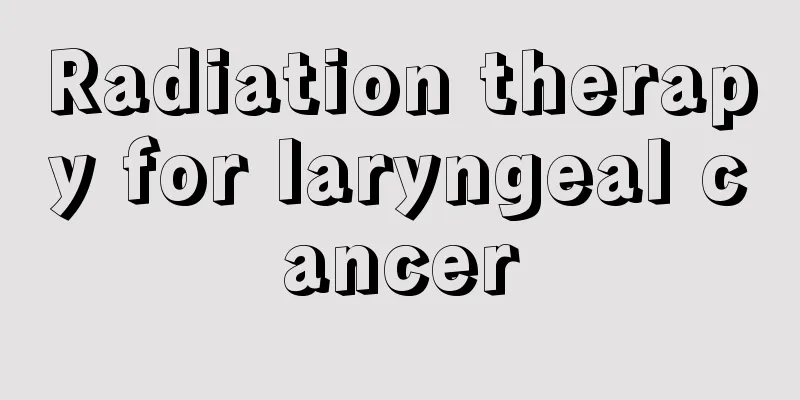Radiation therapy for laryngeal cancer

|
Radiation therapy for laryngeal cancer may include: 1. Radiotherapy alone Patients in the glottic area T1 and T, No stage can be treated with radiotherapy alone. The radiation field is centered on the vocal cord lesion and is 5cmx6cm or 5cmx7cm depending on the size of the lesion. The radiation field is generally centered 0.5cm below the Adam's apple, with the rear edge being the front edge of the cervical spine, the lower edge being the front edge of the cricoid cartilage, and the front edge exceeding the skin. The method and total dose of radiotherapy should be selected according to the size of the lesion: the irradiation dose of T1 lesions should generally not be less than 70Gy/(7-8) weeks; the optimal dose for T3 and T, glottic cancer is about 75Gy/(7-8) weeks; conventional radiotherapy is often used, and hyperfractionated radiotherapy can also be used. 2. Preoperative radiotherapy refers to the combination of planned radiotherapy and surgery, with the purpose of reducing postoperative recurrence and improving the cure rate. It is mainly suitable for patients with cervical lymph node metastasis or cervical lymph node metastasis, and patients with insignificant effect of radiotherapy alone; preoperative radiotherapy is also often used for cases with infiltrative or ulcerative primary lesions. Preoperative radiotherapy generally irradiates 40-50Gy, and surgery is performed after resting for 3-4 weeks. If there is cervical lymph node metastasis, it should be included in the irradiation field. . 3. Postoperative radiotherapy Postoperative radiotherapy is mostly used in cases of advanced laryngeal cancer who are directly undergoing radical surgery. During the operation, it is found that a certain part cannot be completely removed or during the pathological examination of the surgical specimen, cancer cells are found to remain at the resection margin. Postoperative radiotherapy should be performed as soon as possible and generally should not exceed 2 weeks. The general dose is about 50-60Gy. Patients undergoing postoperative radiotherapy should use plastic sleeves to prevent electronic contamination from metal sleeves. |
<<: Voice reconstruction after total laryngectomy in patients with laryngeal cancer
>>: Treatment of esophageal cancer
Recommend
How to eat purple mango
Purple mango is also one of the many types of man...
What can I eat during confinement
I believe that many women who have experienced co...
What are the side effects of lipolysis injection for face slimming?
Fat-dissolving injection for face slimming is a v...
How to treat allergic enteritis?
There are many types of enteritis, some are simpl...
Several types of heart failure
Heart failure is a condition in which the heart f...
Why do I always want to defecate but can’t?
Always wanting to defecate but being unable to do...
What to do if the tattoo cannot be washed cleanly
Nowadays, many people have a good impression of t...
What should I do if I keep having nightmares at night
Dreams can be said to be very wonderful. Of cours...
What is the difference between dill and fennel
Dill has another name called wild fennel, so many...
What causes brain tumors?
If you want to effectively treat brain tumors and...
Will you not get lung cancer if you don't smoke? Here are six tips to prevent lung cancer
Nowadays, the incidence of lung cancer is getting...
What nursing measures should be taken for burn patients?
Burns are wounds that occur when external high-te...
What is an osteosarcoma attack like?
What is the onset of osteosarcoma like? Speaking ...
What's the matter with frequent urination in summer
Frequent urination should be considered a patholo...
Diagnostic basis of gallbladder cancer
What is the diagnosis basis of gallbladder cancer...









